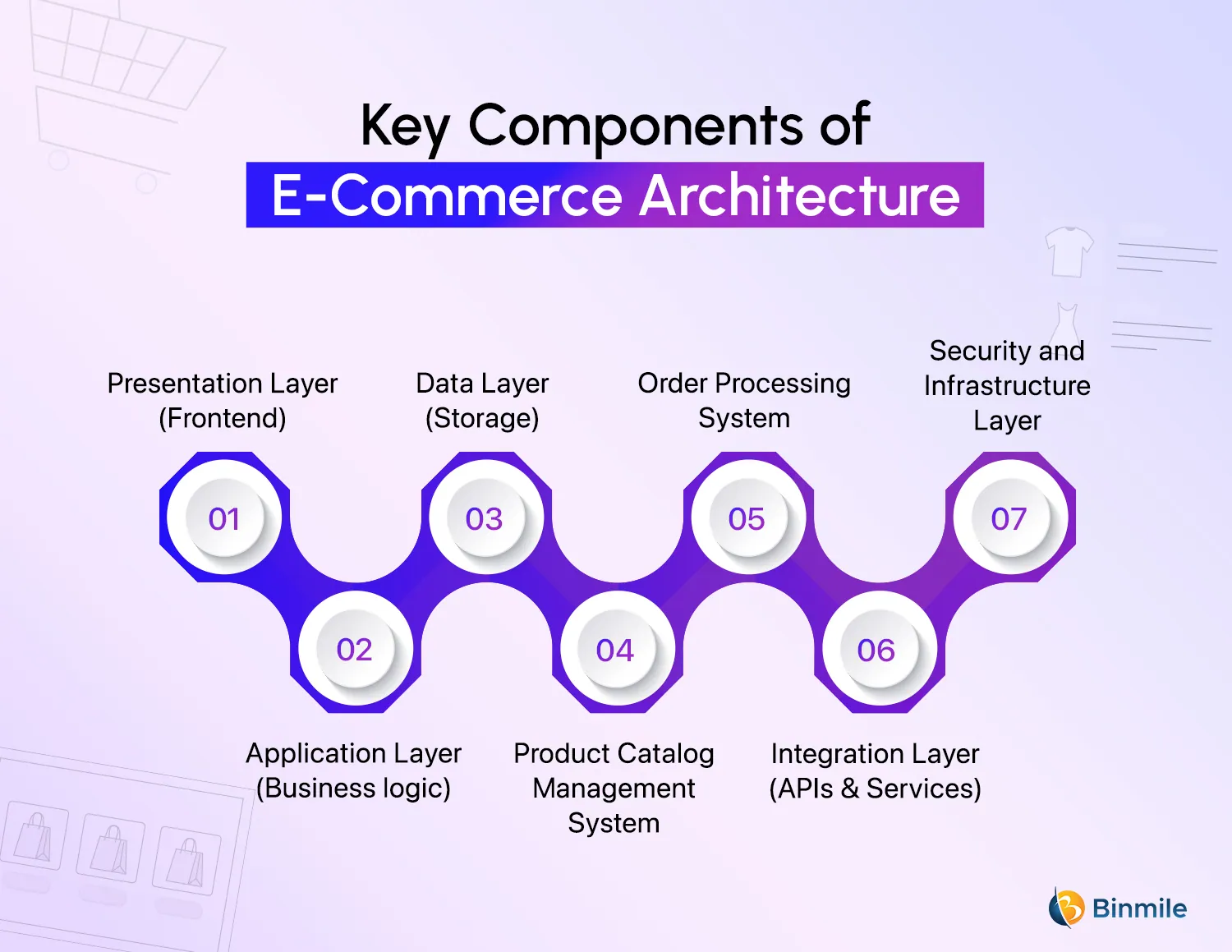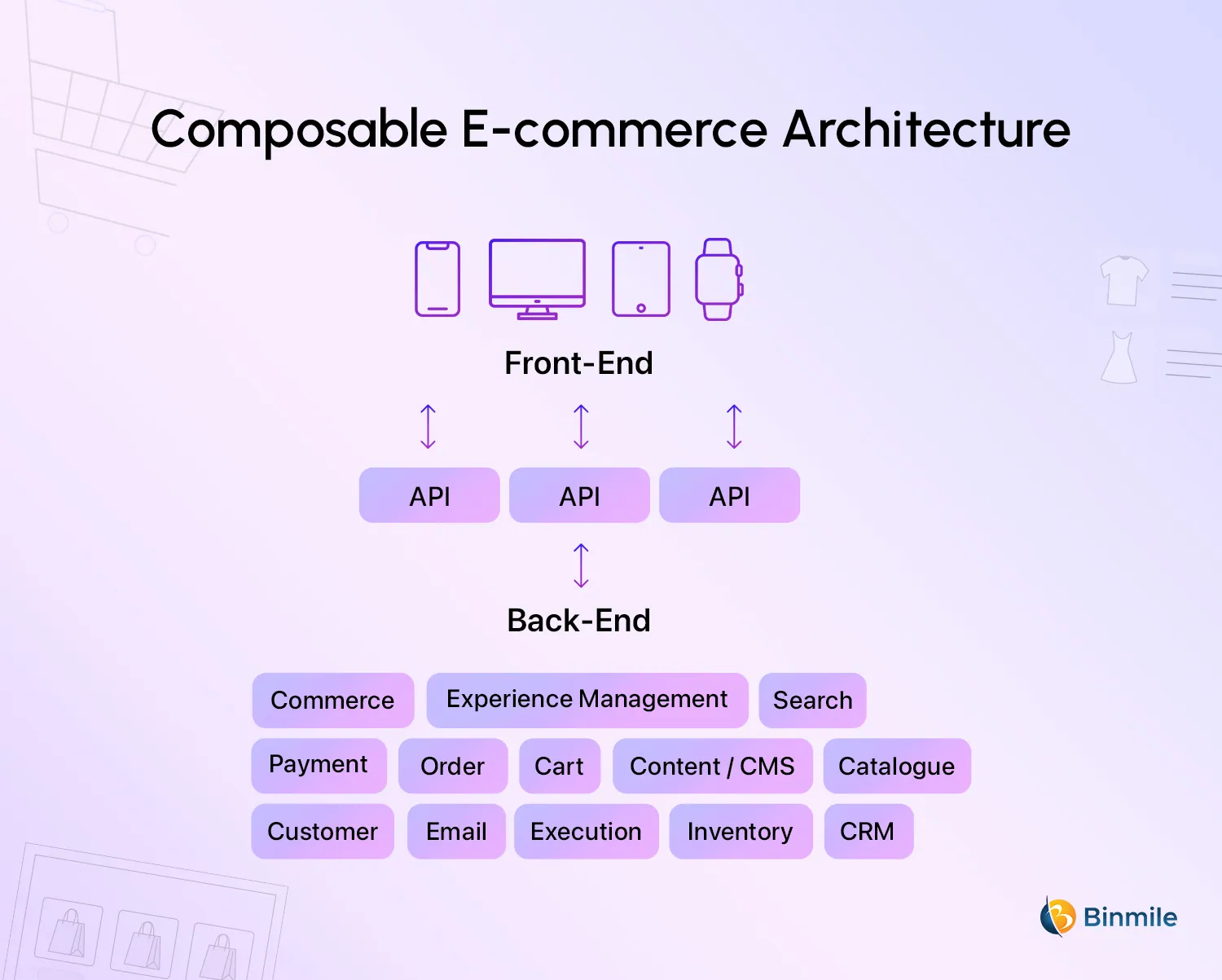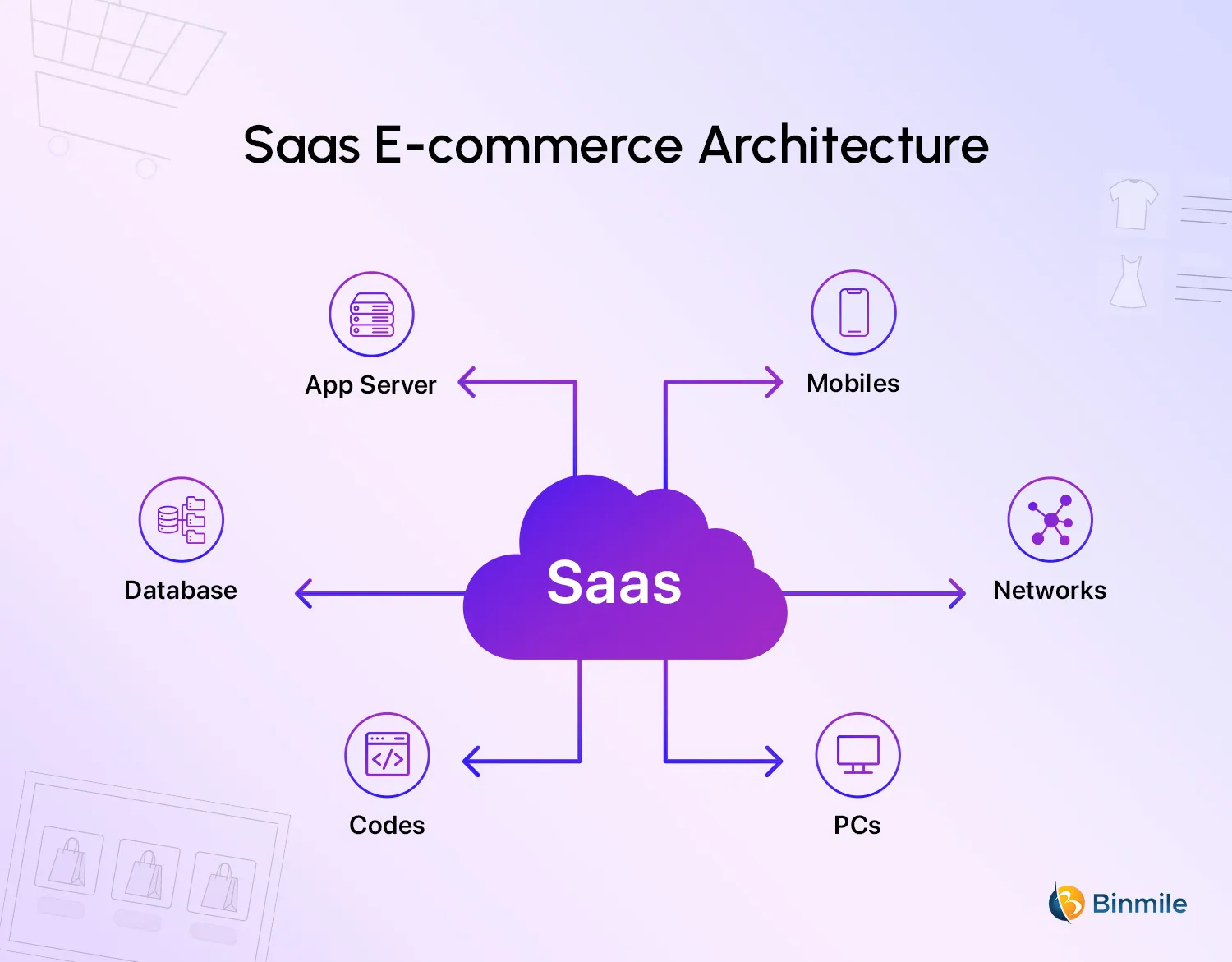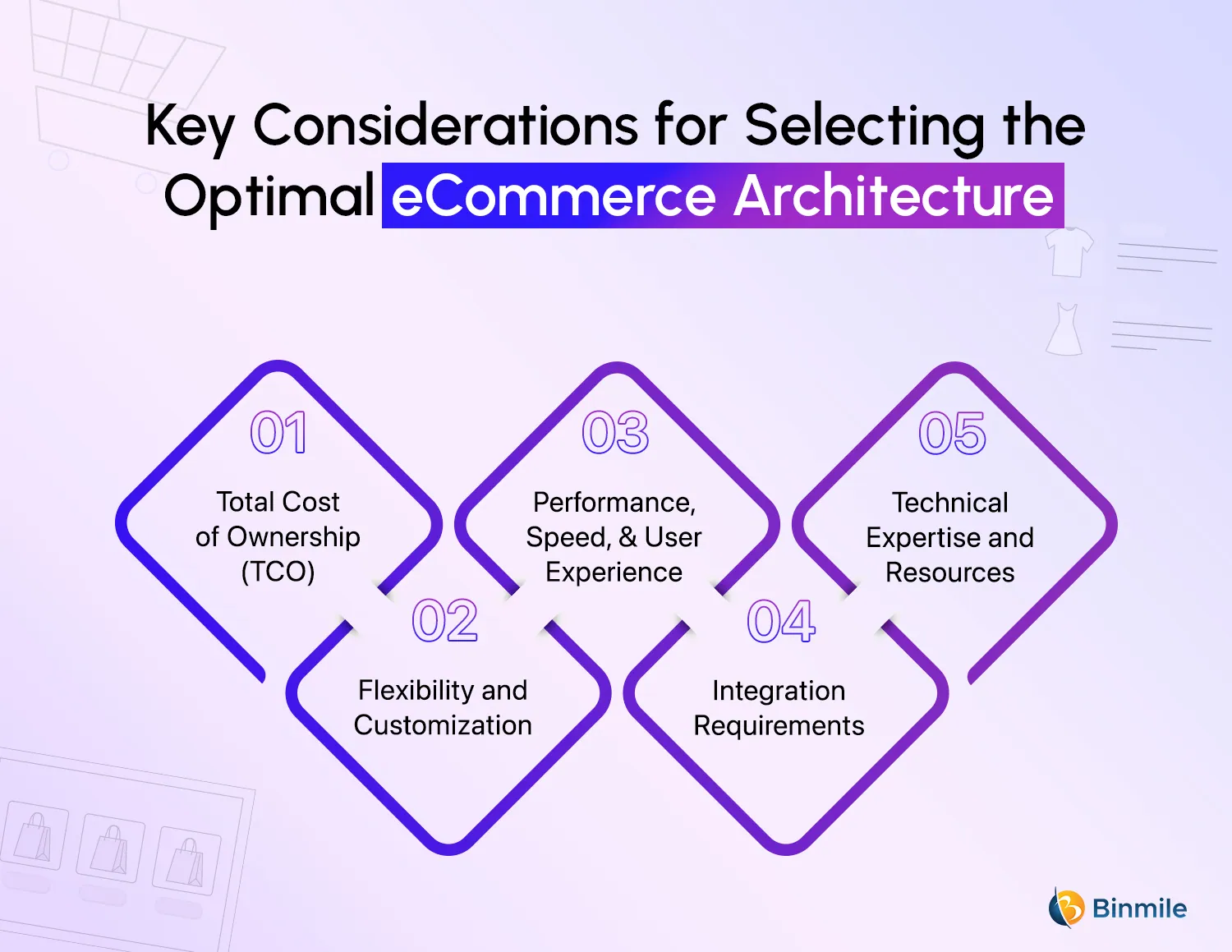- architectural framework of e commerce
- architecture for e commerce website
- Benefits of E-commerce Architecture
- Components of E-Commerce Architecture
- concept of E-commerce architecture
- ecommerce platform architecture
- ecommerce site architecture
- how to choose the ecommerce architecture
- improve commerce architecture
- successful e-commerce architecture
- Types of E-commerce Architectures
- web-based e-commerce architecture
Developing a successful e-commerce business isn’t about having excellent content delivery, checkout functionalities, or top-notch SEO practices. The best online stores are the ones that create a memorable customer experience, but that experience may be enhanced by one-click checkout or personalization tools. 76% of customers prefer convenience when choosing a retail online store, while 9 out of 10 users admitted to liking an online store providing a seamless shopping experience. It becomes essential that your e-commerce website is running smoothly, and that is possible only if you have a solid foundation — and a solid foundation comes from the exemplary eCommerce architecture.
This blog explores the concept of E-commerce architecture, its various types, and their relevance to different business scenarios. Whether you’re looking to enhance scalability, integrate third-party systems, or deliver seamless user experiences, this guide offers valuable insights to help you choose the best architecture to drive growth and innovation for your E-commerce platform.
What is E-commerce Architecture?
An E-commerce architecture is the entire technical design and infrastructure of an online store. It also refers to the style of organizing and structuring a digital or online E-commerce platform or system. To put it simply, a web-based e-commerce architecture is the framework of your online business website, helping it grow, be seen, and ensure a better user experience.
What are the Components of E-Commerce Architecture?

- Presentation Layer (Frontend): It plays a crucial role in providing users with a user-friendly interface. It enables users to browse products and complete transactions through navigation menus, checkout procedures, and shopping carts. The system uses responsive web technologies to ensure a consistent experience on any device.
- Application Layer (Business logic): It is the primary processing engine of the e-commerce platform. It controls key business processes such as cart administration, order pipelines, user authentication procedures, and business protocols. This layer ensures the smooth operation of the platform and maintains transaction integrity throughout the application runtime.
- Data Layer (Storage): This layer manages product catalogs, customer profiles, inventory details, and transaction records. It can support both structured and unstructured database formats to maximize diverse data requirements.
- Product Catalog Management System: It includes specific tools and databases that provide systems to optimize product information, digital assets, categories and pricing models, and inventory tracking for an efficient searching and browsing experience.
- Order Processing System: It administers order management procedures, starting with shopping cart activity and progressing to payment collection and distribution, as well as return management.
- Integration Layer (APIs & Services): This component establishes the connection between the e-commerce platform and external systems such as payment gateways, shipping providers, accounting systems, CRM platforms, and marketing tools through APIs and services.
- Security and Infrastructure Layer: This layer offers data protection, system reliability, and performance optimization. It thus enables encryption, authentication protocols, and cloud infrastructure management to maintain operational stability and security compliance.
Benefits of Choosing the Right E-commerce Architecture
- It helps your E-commerce website get indexed and ranked higher in search engines. However, make sure the website is well-organized.
- No need to design your website from the ground up. It allows you to upgrade and add necessary functions to an existing website, provided you are aware of how new changes would affect the rest of the parts and structures of your website.
- It offers a better user experience with integrations—such as payment gateways, shipping providers, and analytics tools- and enhances functionality without overloading your core system.
- E-commerce business platforms can drive better user experience and more sales when they provide seamless customer experience.
- It ensures your inventory, orders, and customer data remain accurate and up to date with real-time data syncing across systems so you get consistent data throughout all sales channels.
Are you struggling to make your mark in the digital marketplace? Get a free consultation to master eCommerce website or app development and fuel your business growth!
Exploring the Types of E-commerce Architectures
E-commerce architecture is a crucial aspect of building an e-commerce website capable of driving more user experience and more sales as a result of improved traffic on your website. It’s important to have a good grasp of the most critical architectural frameworks of e-commerce to make informed decisions and be prepared for the challenges and opportunities they present.
1: Monolith E-commerce Architecture
It is a unified system consisting of all the features in a vast codebase and many vital components, such as the data access layer, user interface, and business logic layer.
Pros of Monolith E-commerce Architecture:
- Since it contains all the functions in one place, it is easily implementable and maintainable
- Things are less likely to go wrong, as everything is integrated
- With all the functionality in one place, it allows building and testing new features faster
- No higher cost to set up and maintain the architecture
Cons of Monolith E-Commerce Architecture:
- Complex scalability leading to bottlenecks
- Can’t be adapted to new business needs. Hard to integrate with other systems
- Hard to isolate and fix problems, as a failure in one component can adversely affect the entire system
2: Microservice E-commerce Architecture
Microservices segment an E-commerce system into small, independent services that communicate with each other through multiple API interfaces. The main upside of microservices is that they function as subsystems relying on their business logic and architecture. They also permit greater flexibility and scalability.
Pros of Microservice Architecture:
- Easy scalability without hampering the entire system
- Easy to develop, deploy, and scale
- If one service doesn’t work, it doesn’t affect the rest of the systems, leading to better fault tolerance
- Easy to understand each mode’s functionality
- Enables independent deployment of each model without rebuilding and deploying an entire application
Cons of Microservice Architecture:
- Can’t be implemented and maintained due to the complexity
- More communication overhead hampers the system and augments the risk of errors
- Costly development, deployment, and maintenance compared to monolithic architecture
- Requires specialized skill sets and more infrastructure
Monolith vs Microservice E-commerce Architecture: Which One to Choose?
- Choose a monolith framework if your e-commerce site needs to launch quickly. It provides a comprehensive solution for simple stores.
- Select microservices for developing large-scale platforms that require independent scaling of services that include cart systems, payments, and inventory management.
- Opt for monolith when you have both small teams and limited expertise in distributed platform management.
- Going for microservices will allow your organization to achieve continuous deployment together with autonomous development cycles between teams.
- Choose monolith as your framework since it provides simple implementations and cost-effective development that outweighs scalability requirements.
3: Two-Tier Architecture
It facilitates direct communication between the interface layer (client) and the data layer of the E-commerce platform. However, a straightforward architecture like this also makes it challenging to scale the system or add new functionality.
Pros of Two-Tier Architecture:
- Easy to develop, add, and test new features
- Easy to understand and work with
- Reduces traffic loads and improves data processing efficiency
- Prevents concurrent modifications by using transaction control
- Not costly to set up and maintain
Cons of Two-Tier Architecture:
- Can’t tackle abrupt load fluctuations
- Limited capacity to scale, thus resulting in bottlenecks as the business grows
- Hard to change and adapt to new business needs
- More vulnerable due to the lack of an additional layer for protection and validation
4: Three-Tier Architecture
It consists of an extra middle-tier architecture for managing client and server data flow. The architecture can also handle data validation functions and authentication.
Pros of Three-Tier Architecture:
- More flexible in terms of technology choices
- Reusable components allow for cost savings and rapid development
- Improves data integrity by providing an additional layer for security and validation
- Can be scaled faster
Cons of Three-Tier Architecture:
- Difficult to scale, as layers handle data volume surges or traffic loads with significant modifications
- More expensive than a two-tier architecture in terms of development, deployment, and maintenance
- More complex and time-consuming to upgrade
- Results in more latency and a slowdown in response times for customers
Two-Tier vs Three-Tier Architecture: Which is Better?
- Develop your lightweight eCommerce app using two-tier since it supports a simple client-server model.
- Choose a three-tier architecture selection when developers need presentation separation from business logic and data storage layers to create a better maintainable system.
- Build an MVP with two-tier architecture to achieve faster market entry through minimal integration complexities.
- If you expect future integration of external systems and application growth, then go for a three-tier architecture.
- Better security combined with load-balancing performance between layers makes the three-tier model the preferred option.
5: Composable E-commerce Architecture
This architecture refers to an E-commerce platform’s different services that can be developed and deployed in other ways to cater to specific business requirements.
Pros of Composable Architecture:
- Services can be configured differently to suit specific business needs
- New services can be added to the platform without hampering the functionality of existing ones
- Independent scalability of services
- Easy optimization of the platform for specific business needs
Cons of Composable Architecture:
- Challenging in terms of implementation and maintenance as it’s too complex
- Difficult to deal with by a less experienced team
- The system is prone to a slowdown and error, as services communicate via APIs
- Expensive operational costs
6: Headless Architecture
This architecture shows the front-end presentation layer (showcasing user interface and handling user interactions) separated from the back-end functionality, such as inventory management, payment processing, etc.
Pros of Headless Architecture:
- Flexibility when using technologies for front-end and back-end
- Easy integration with other systems
- Easy to optimize front-end to ensure an improved customer experience
- Easy to maximize back-end for greater scalability and enhanced security
Cons of Headless Architecture:
- Hard to implement and maintain for businesses with a less skilled development team
- Prone to slowing down and errors due to communication overload
- Expensive development, deployment, and maintenance
Composable Commerce vs Headless Commerce Architecture: Which One to Choose?
- Choose a composable approach when you want maximum flexibility in selecting different vendors for commerce functionality (payment, search, and CMS).
- Select headless architecture to maintain a unified backend system even if you want to decouple the frontend.
- Choose composable when you want to customize your stack according to different markets or brands within the same ecosystem.
- Opting for headless e-commerce architecture allows organizations to provide homogeneous content across various channels without replatforming the backend.
- Select composable architecture when your business needs quick experimentation opportunities and integration with best-of-breed APIs.
7: SaaS eCommerce Architecture
The Software-as-a-Service (SaaS) architectural framework of e-commerce is a web-based, out-of-the-box solution in which a third-party provider manages e-commerce functionalities. The provider—Shopify, for example—is responsible for maintaining, hosting, and upgrading existing settings.
Pros of SaaS eCommerce Architecture
- Quick setup with no technical expertise needed.
- Vendors handle all maintenance and security.
- Predictable subscription pricing models.
- Automatic scaling for traffic spikes.
- Built-in app ecosystems for easy extensions.
Cons of the SaaS Architectural Framework of E-commerce:
- Limited customization options.
- Dependency on third-party providers.
- Data ownership and portability concerns.
- Potentially higher long-term costs than self-hosted options.
Shape the future of eCommerce—leverage next-gen architecture to drive growth and wow your customers!
How to Choose the Best E-commerce Architecture for Your Business
Once you are done finalizing your business requirements and scalability goals, it is time to consider other crucial factors. Consider these critical elements to decide the best eCommerce architecture:
1. Total Cost of Ownership (TCO)
Assess the total cost of ownership not just the initial setup cost but also long-term expenses like hosting, maintenance, third-party tools, developer resources, and licensing. Cloud-based or SaaS platforms might offer lower upfront costs, while composable or microservice architectures can become expensive to manage over time.
2. Flexibility and Customization
Consider how easily you can modify or extend the system. This is crucial for operating a website with zero downtime and offering your users a seamless buying experience. Headless and composable architectures provide high flexibility, allowing you to customize frontends and integrate with best-of-breed services.
3. Performance, Speed, and User Experience
These three elements can make or break your website’s success and quick adoption. Therefore, choose an architecture that supports fast page loads, responsive design, and a smooth customer journey. Your system should handle traffic spikes and ensure minimal downtime during peak shopping seasons.
4. Integration Requirements
Check whether the architecture supports seamless integration with essential third-party services like payment gateways, ERP, CRM, and logistics tools. Remember, a robust API layer is critical for long-term adaptability and also a deciding factor for your customers to stay loyal to your brand.
5. Technical Expertise and Resources
Evaluate your in-house team’s technical capabilities. For better assistance, hire an eCommerce website development company that has expertise in Microservices and composable commerce, which require more development and maintenance effort, or monolithic or SaaS-based solutions, which are easier to manage.
Also Read : Zero click ecommerce shopping.
Your eCommerce solution is just a click away! Discover how Binmile's expert app developers build a stunning app or marketplace that sets you apart.
Final Thoughts
An eCommerce architecture provides a solid groundwork for enhanced visibility online and profitable growth for E-commerce businesses. Therefore, choosing the best architecture type is essential to ensure you have the best technical assistance to support your business requirements. When it comes to choosing the best architecture type, don’t forget to evaluate your current architecture in terms of scalability, performance, reusability, and cost-effectiveness. Once done, try to focus on the components of e-commerce architecture that you think is conducive to your E-commerce needs.
If you are still confused, consider hiring a reputable app development company. Choosing the best e-commerce architectural framework can be overwhelming, especially if your development team is less skilled. Binmile, for example, can best serve your business requirements. We have a team of highly proficient IT specialists who build futuristic software solutions for E-commerce and other industry players.
Frequently Asked Questions
An efficient e-commerce platform architecture boosts business growth by enhancing website performance, ensuring faster load times, and improving scalability. It streamlines user experience, supports secure transactions, and enables seamless integrations — all of which drive customer satisfaction, increase conversions, and promote long-term success in the competitive e-commerce landscape.
Modern e-commerce architecture is crucial for online businesses as it enhances flexibility, scalability, and performance. By leveraging microservices, APIs, and cloud solutions, businesses can easily adapt to changing demands, integrate new features, and deliver seamless user experiences — ensuring long-term growth and improved operational efficiency.
The architectural framework of e-commerce refers to the structural design that outlines how various components, like databases, servers, and user interfaces, interact to deliver a seamless shopping experience.
The main components of e-commerce architecture include:
- User Interface (UI): For seamless customer interactions
- Database Management: For secure data storage
- Payment Gateway Integration: For secure transactions
- Inventory Management Systems: To track product availability
Each model requires specific architectural considerations:
- B2C demands scalable, user-friendly frontends with robust payment gateways and high-performance databases to handle consumer traffic.
- B2B needs features like bulk order processing, role-based access control, and integration with ERP systems, requiring complex backend logic.
- C2C requires secure marketplace functionalities, escrow systems, and user authentication, emphasizing trust and moderation systems.
- C2B focuses on flexible APIs and workflows to allow businesses to evaluate consumer offerings, often needing dynamic data models.

















